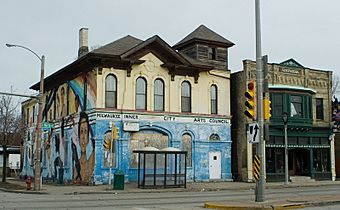Chief Lippert Fire Station facts for kids
Quick facts for kids |
|
|
Chief Lippert Fire Station
|
|
 |
|
| Lua error in Module:Location_map at line 420: attempt to index field 'wikibase' (a nil value). | |
| Location | 642 W. North Ave., Milwaukee, Wisconsin |
|---|---|
| Area | less than one acre |
| Built | 1876 |
| Architect | Thomas Philpot |
| Architectural style | Italianate |
| NRHP reference No. | 88002007 |
| Added to NRHP | January 1, 1989 |
The Chief Lippert Fire Station is a very old and important building in Milwaukee, Wisconsin. It was built way back in 1876. This station was first known as Chemical Engine House No. 1. It is a special historic place and was added to the National Register of Historic Places in 1988.
Contents
How Milwaukee Fought Fires Long Ago
Early Firefighting Efforts
Imagine a time when there were no big fire trucks! Milwaukee's fire department started in 1837. It was a small group of volunteers. They used simple tools like buckets, axes, and ladders. These were all kept in a small shed downtown.
In 1839, they got their first "fire engine." This was a hand-operated pump on a wagon. Men had to pull it to fires themselves! They named this first engine Neptune.
Growing the Fire Department
Over the years, Milwaukee's fire system got much better. In the 1850s, the city was divided into different fire areas. By the 1860s, they bought bigger pumps. These pumps could spray water high enough to reach the top floors of five-story buildings. Horses were also added to pull the heavy pumps.
The city also started paying firefighters. Before, everyone was a volunteer. In 1869, a system of fire alarm boxes was set up. These boxes were connected by miles of telegraph lines. This meant people could quickly report fires.
Chief Henry Lippert's Role
The first full-time paid firefighters started in 1874. This was when Henry Lippert was the fire chief. Chief Lippert came from Germany. He had worked his way up through the volunteer fire department. He helped make the fire department more professional.
Building the Chief Lippert Fire Station
Why a New Station Was Needed
In 1876, the city built Chemical Engine House No. 1. This building would later be named the Chief Lippert Station. It was built in a new, growing neighborhood north of downtown. Many houses there were made of wood and built close together. This meant fires could spread quickly.
But there was a problem: city water pipes hadn't reached this area yet. Homes used private wells, which didn't have enough water for big fire pumps. So, the new station was built for a "chemical fire engine." This engine used chemicals to put out fires, much like a giant fire extinguisher.
The Station's Design and Look
The building itself was two stories tall. It was made of cream-colored brick. The roof was shaped like a hip roof, which slopes on all four sides. A Milwaukee architect named Thomas N. Philpot designed it. He used the Italianate style. This style often features wide wooden eaves and a decorative gable at the front.
The brickwork looks like tall, flat columns called pilasters. The windows have round arches at the top. A tall wooden tower was added around 1883. It was originally seven stories high! Firefighters used it as a watch tower. From there, they could look for smoke across the city.
Changes Over the Years
From Chemical to Steam to Motorized
By 1883, water pipes finally reached the neighborhood. So, the chemical engine was no longer needed. It was replaced with a steam-powered fire engine. Horses pulled this new engine.
In 1908, a two-story cream brick section was added to the back of the building. This part was for the horses and their hay. It was designed by Sebastian Brand, who was also a firefighter.
Motorized fire trucks started to appear in Milwaukee in 1915. But the Lippert station kept its horses until 1927.
The Watch Tower and New Uses
In the 1930s, the tall watch tower wasn't needed anymore. People could just call in fires using telephones. So, most of the old wooden tower was taken down. Only three stories of it remain today.
The Lippert station stopped being a fire station in 1948. After that, it was used for different things. It was a branch library starting in 1951. Later, it housed offices for the Model Cities Program in 1972. In 1977, it became the home of the Inner City Arts Council. This group even painted a mural on the building's west side in 1984.
Why This Station Is Special Today
The Chief Lippert Station is Milwaukee's oldest fire station that is still in great shape. It was one of the first stations designed with living areas for the firefighters. Before, fire stations were just simple sheds for equipment.
It's also the only public building left in Milwaukee from that time that uses the Italianate style. Many other city buildings, like the old city hall, firehouses, and schools, used this style back then.

